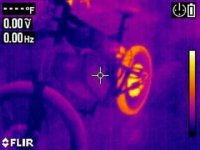Ianhill
1 MW
- Joined
- Sep 25, 2015
- Messages
- 2,871
Exactly what it says on the tin tab cooling prismatics.
Whats the best method for simplicity but effectiveness.
Im thinking spot weld the tabs together then use an electrically isolating heat conducting pad so simular to what fets use that way i have a direct path from the internal foils.
water cooling over time can result in a conductive liquid if neglected and that would give an electical path between cells if there was no isolation between cooling block and tab so the thermal pad suits 2 purposes not only is it the heat transfer medium but the insulator too.
A thermal paste outperforms a pad but in this instance the pad is a good choice for the twin purpose and then off to a cooling radiator to take the heat away.
Does anyone have an input on this idea, i suppose tesla new cells would be the only cylindrical cell worth doing this too the 18650 and alike are the geared hub motor of the battery world case cooling or tab not really effective as a prisamatic tab cooled cell or the new 4680 cell.
I want to do this for a gokart idea i got the cells will be on the limit so need help or ill be lucky to get 150 cycles out if them but im going to design this clever so its not a big weight block on the side its going to be flat and in the floor pan 700×300×40mm in cell dimesion for a 21s 60ah pack then i got to apply a box and cooling
Whats the best method for simplicity but effectiveness.
Im thinking spot weld the tabs together then use an electrically isolating heat conducting pad so simular to what fets use that way i have a direct path from the internal foils.
water cooling over time can result in a conductive liquid if neglected and that would give an electical path between cells if there was no isolation between cooling block and tab so the thermal pad suits 2 purposes not only is it the heat transfer medium but the insulator too.
A thermal paste outperforms a pad but in this instance the pad is a good choice for the twin purpose and then off to a cooling radiator to take the heat away.
Does anyone have an input on this idea, i suppose tesla new cells would be the only cylindrical cell worth doing this too the 18650 and alike are the geared hub motor of the battery world case cooling or tab not really effective as a prisamatic tab cooled cell or the new 4680 cell.
I want to do this for a gokart idea i got the cells will be on the limit so need help or ill be lucky to get 150 cycles out if them but im going to design this clever so its not a big weight block on the side its going to be flat and in the floor pan 700×300×40mm in cell dimesion for a 21s 60ah pack then i got to apply a box and cooling


